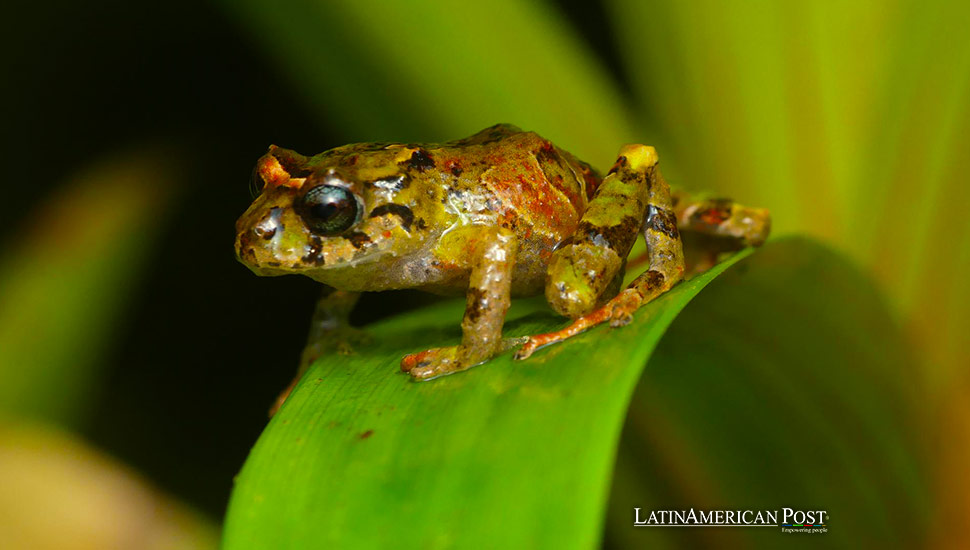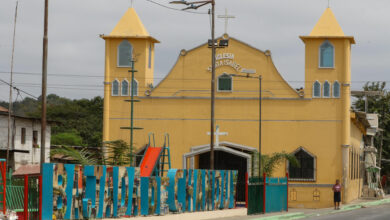New Frog Species Discovered in Ecuador Honors Conservationist Norma Ewing

A new frog species, Pristimantis normaewingae, was discovered in Ecuador’s Cerro Candelaria reserve. It is named after American conservationist Norma Ewing, highlighting the region’s rich biodiversity and ongoing conservation efforts.
In a thrilling breakthrough for biodiversity and conservation, scientists in Ecuador have unearthed a new species of frog, Pristimantis normaewingae. The National Biodiversity Institute (Inabio) unveiled this exhilarating find, which pays tribute to Norma Ewing, a passionate American conservationist and animal rescue volunteer. The discovery took place in the secluded Cerro Candelaria reserve, a part of the Llanganates-Sangay corridor, a region renowned for its abundant and distinct biodiversity.
The newly identified species was found in the cloud forests of Cerro Candelaria, situated between 2,550 and 3,150 meters above sea level in the eastern Andes. Nestled between the Andes and the Amazon and flanked by the Llanganates and Sangay National Parks, this area is one of Ecuador’s most biodiverse and endemic regions. The habitat’s mix of altitude, climate, and ecosystems makes it a hotspot for biological discoveries.
Researchers from Inabio, Fundación Ecominga, Fundación Oscar Efrén Reyes, La Sapada Equipo Herpetológico, and The Youth Land Trust collaborated on this significant find. The frog, a member of the Pristimantis anaiae group, stands out due to its unique physical characteristics. These include incomplete oval markings in the sacral region, a row of enlarged dorsolateral tubercles, and a distinctive light blue iris with a broad horizontal copper band with black reticulations. These features make it a fascinating addition to the biodiversity of the region.
Genetic and Morphological Analysis
The genetic and morphological analysis of Pristimantis normaewingae was conducted at Inabio’s Nucleic Acid Sequencing Laboratory in Quito and Sumak Kawsay in Situ (SKIS) in the tropical rainforest of Pastaza. This rigorous scientific process involved extracting and sequencing DNA, constructing phylogenetic trees to understand the frog’s evolutionary relationships, and detailed taxonomic comparisons to identify its unique features. These analyses confirmed the frog as a new species within the diverse Pristimantis genus, which has seen a rapid increase in known species in the northern Andes over the past decade.
Ecuador is globally recognized for its exceptional biodiversity, particularly within the Andes. The revelation of Pristimantis normaewingae adds to this region’s expanding list of endemic and endangered species. Since 2010, fourteen new species of Pristimantis have been identified in the upper Pastaza River basin, underscoring the region’s status as a hub of endemism and the need for its preservation.
The Llanganates-Sangay corridor, where Cerro Candelaria is located, features various conservation areas, including the Private Protected Area of Cerro Candelaria. This reserve spans 2,696 hectares from cloud forest to páramo ecosystems, making it a crucial habitat for a wide range of species. The area has been the type locality for five new frog species, and many areas within the corridor remain unexplored, promising further discoveries of biodiversity. The reserve’s protection of a broad altitude gradient, from 1,500 to 3,840 meters, ensures the preservation of multiple habitats critical for numerous species, including the newly discovered frog.
Conservation Efforts and Future Prospects
The discovery of Pristimantis normaewingae underscores the importance of conservation efforts in Ecuador. The Cerro Candelaria reserve, one of the significant conservation areas within the Llanganates-Sangay corridor, protects various ecosystems and supports ongoing scientific research. However, the frog’s habitat is under threat from deforestation, climate change, and illegal wildlife trade. This reserve’s protection of a broad altitude gradient, from 1,500 to 3,840 meters, ensures the preservation of multiple habitats critical for numerous species, including the newly discovered frog.
Diego Inclán, executive director of Inabio, highlighted the rapid growth in Ecuador’s described amphibian species over the past decade, from around 300 to nearly 700. This increase is attributed to the diligent work of national researchers and the country’s commitment to scientific development. Inclán anticipates this trend will accelerate as scientific activities expand, revealing even more of Ecuador’s hidden biodiversity. This not only promises exciting discoveries but also underscores the need for continued conservation efforts to protect these unique species and their habitats.
Latin America plays a crucial role in global biodiversity conservation. Its vast and diverse ecosystems, ranging from the Amazon rainforest to the Andes mountains, harbor many of the world’s species. Ecuador, in particular, stands out for its high levels of endemism and biodiversity. The discovery of Pristimantis normaewingae is a testament to this rich natural heritage and the importance of preserving these ecosystems for the benefit of the entire planet.
The discovery of Pristimantis normaewingae is a testament to Latin America’s rich natural heritage and the importance of preserving these ecosystems. Conservation initiatives in Ecuador, such as creating protected areas and promoting scientific research, are vital in safeguarding this biodiversity for future generations.
Honoring Norma Ewing
The new frog species is being named after Norma Ewing, a testament to her significant contributions to conservation and animal rescue. Ewing’s work is a shining example of the impact that dedicated individuals can have on preserving the natural world. By acknowledging her efforts, the scientific community is highlighting the power of global cooperation and individual commitment in tackling environmental challenges, inspiring others to follow in her footsteps.
The discovery of Pristimantis normaewingae in Ecuador’s Cerro Candelaria reserve is a significant event in the scientific community. It not only highlights the region’s extraordinary biodiversity but also underscores the critical role of conservation efforts. As scientists continue to explore these rich ecosystems, more species are likely to be uncovered, further emphasizing the importance of protecting these habitats. This discovery also contributes to our understanding of the evolution and diversity of the Pristimantis genus, a topic of great interest to biologists and conservationists.
Also read: Ecuador’s Biodiversity Shines in Captivating Photo Exhibition “Ecuador in Images”
Ecuador’s commitment to biodiversity conservation and scientific research serves as a model for other nations in Latin America and beyond. The country is paving the way for a sustainable future where biodiversity is celebrated and preserved by fostering a deeper understanding of the natural world and honoring individuals like Norma Ewing.




